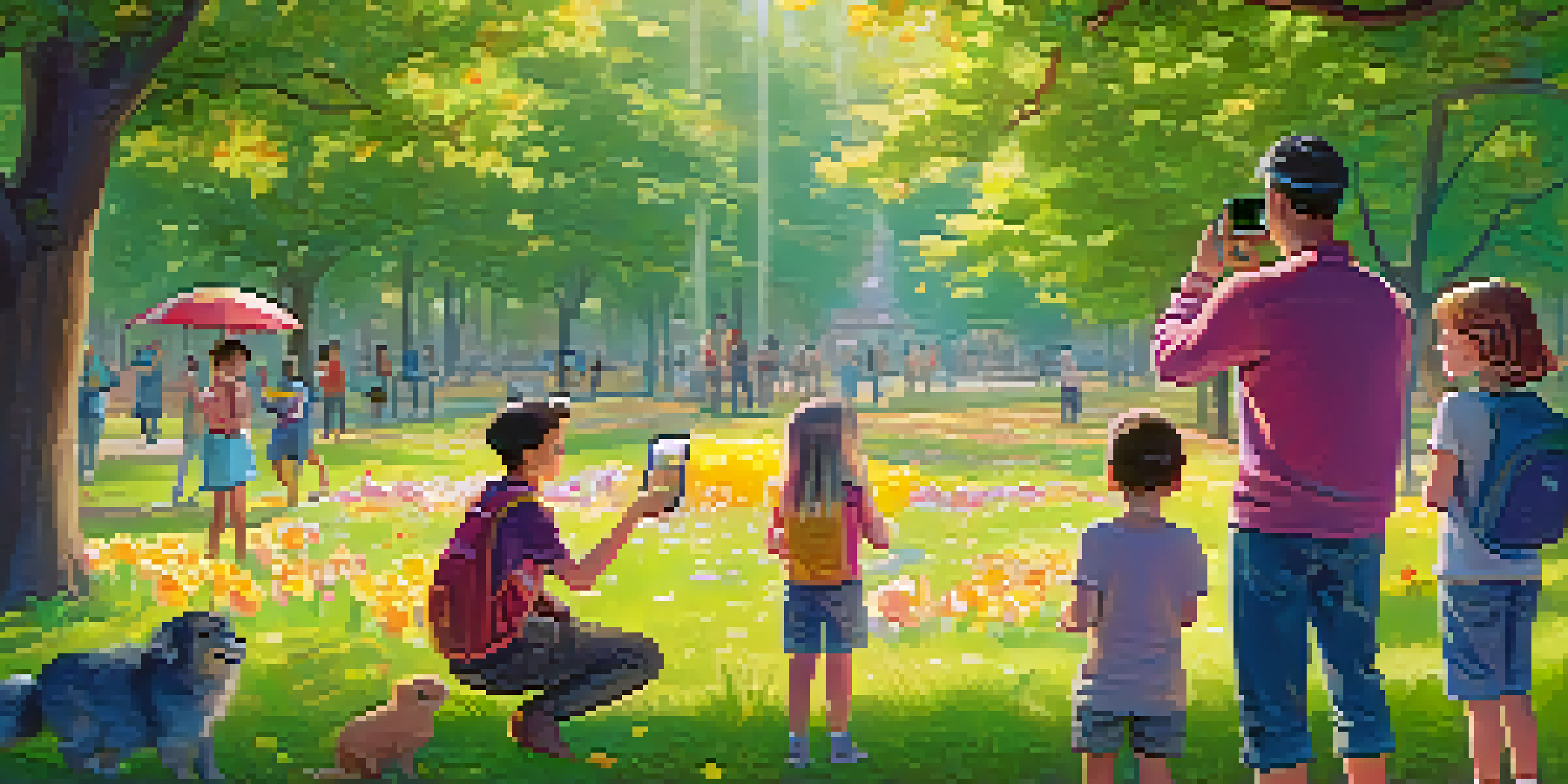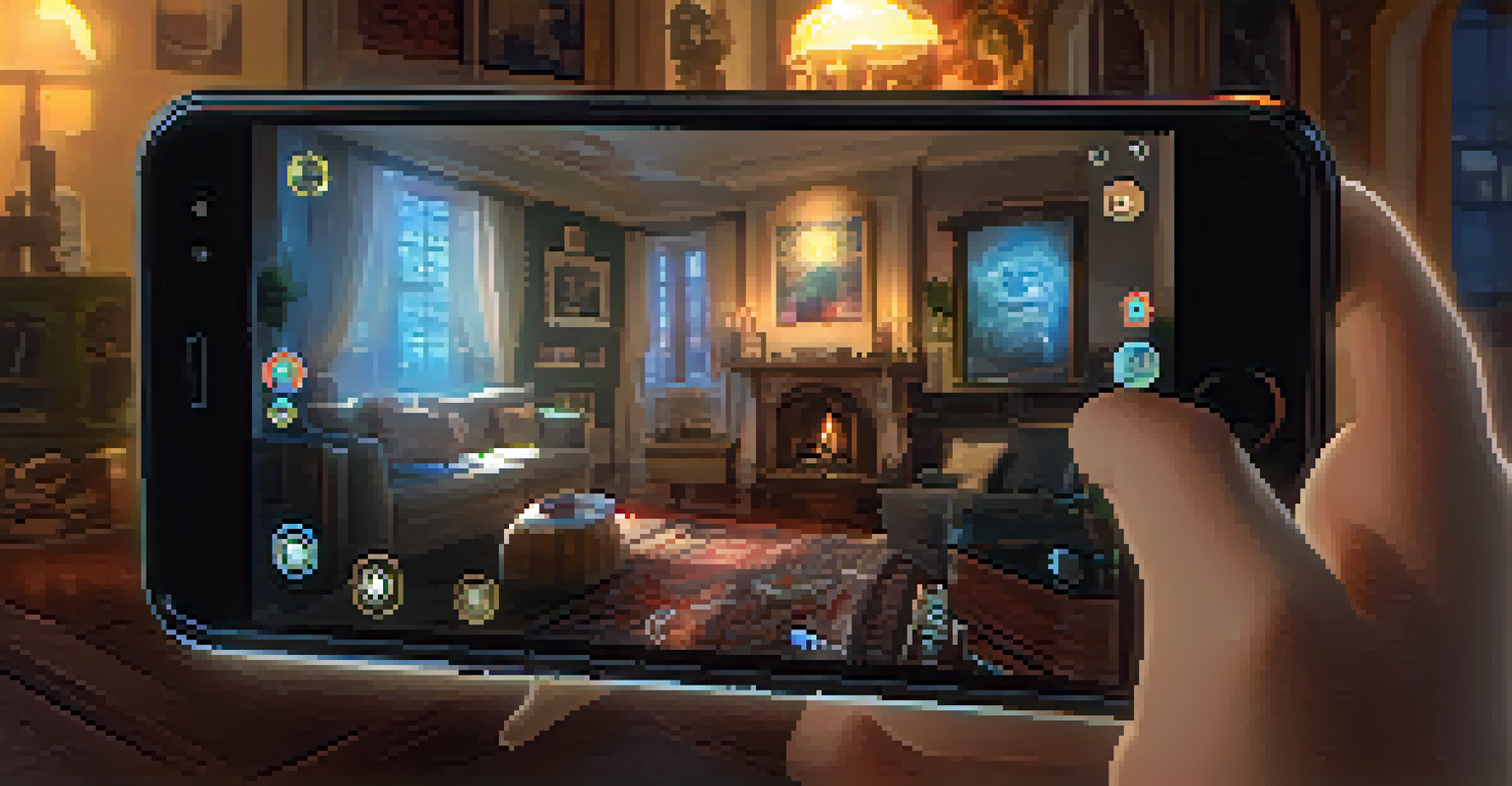Augmented Reality: Bridging the Gap Between Film and Reality

Understanding Augmented Reality in Film
Augmented reality (AR) blends digital elements with the real world, creating an interactive experience. In film, this technology allows audiences to engage with characters and settings like never before. Imagine watching a movie and being able to interact with a character on screen, as if they were right next to you. This seamless integration of digital and physical worlds can fundamentally change how we perceive storytelling.
The real world is more than just a setting; it is a canvas for storytelling.
In essence, AR enhances the viewing experience by immersing audiences in the narrative. For instance, films can use AR to create interactive posters that come to life when viewed through a smartphone. This not only promotes the film but allows fans to explore the story in a new dimension, making them an active part of the experience.
As AR technology matures, its potential in filmmaking continues to expand. From virtual reality (VR) experiences that transport viewers into the film's universe to apps that provide additional content, AR is bridging the gap between film and everyday life, inviting viewers to become part of the story.
The Impact of AR on Storytelling Techniques
AR introduces innovative storytelling techniques that can captivate audiences on multiple levels. Filmmakers can layer information, visuals, and sounds to create a richer narrative experience. For example, a character's backstory might be revealed through an AR app, allowing viewers to explore their past while watching the film unfold.

This interactive approach can evoke deeper emotional connections with the characters and plot. By engaging with the story through AR, viewers are no longer passive observers; they become active participants in the storytelling process. Imagine feeling the tension of a suspenseful scene as you interact with elements that reveal critical clues.
AR Enhances Film Storytelling
Augmented reality provides innovative ways for audiences to engage with narratives, transforming them from passive viewers to active participants.
Moreover, AR's ability to provide real-time information enhances the narrative. As audiences navigate through a film's world, they can access background details or hidden messages that add layers to the overall experience. This multi-dimensional approach can lead to a more profound understanding and appreciation of the film.
Creating Immersive Marketing Campaigns with AR
The integration of AR in film marketing has opened up exciting new avenues for engagement. Movie studios are now using AR to create buzz before a film's release, allowing fans to interact with their favorite characters or scenes. This type of marketing not only builds anticipation but creates a community around the film.
Augmented reality is not just about technology; it's about creating experiences that draw people in.
For example, a recent blockbuster might feature an AR app where users can unlock exclusive content or participate in challenges related to the film. This not only keeps fans engaged but also encourages them to share their experiences on social media, amplifying the film's reach. The more interactive the campaign, the more likely it is to go viral.
As audiences increasingly seek unique experiences, AR marketing campaigns can provide the novelty they crave. By offering immersive interactions, studios can distinguish their films in a crowded market, ensuring they capture the attention of potential viewers.
Examples of AR in Popular Films
Several films have successfully utilized AR to enhance their storytelling and marketing efforts. For instance, the 'Ghostbusters' franchise launched an AR app that allowed fans to catch virtual ghosts around their neighborhoods. This innovative approach not only promoted the film but also created a fun, engaging experience that resonated with audiences.
Another example is the 'Harry Potter: Wizards Unite' game, which brought the magical world of Harry Potter to life through AR. Players could explore their surroundings, interact with familiar characters, and complete challenges, all while feeling like they were part of the story. This innovative blending of gaming and film is a prime example of how AR can create a captivating experience.
Interactive Marketing with AR
Movie studios are leveraging AR to create immersive marketing campaigns that engage fans and build anticipation before a film's release.
These examples illustrate how AR can be used effectively in both storytelling and marketing. As filmmakers continue to explore the possibilities of AR, we can expect to see even more creative applications that push the boundaries of traditional cinema.
The Role of Technology in AR Film Experiences
The backbone of AR in film is technology, which continually evolves to enhance viewer experiences. High-quality graphics and sophisticated tracking systems allow filmmakers to create stunning visual effects that seamlessly blend with real-world environments. This technological advancement makes AR experiences more realistic and engaging.
Moreover, advancements in mobile devices mean that audiences can access AR experiences right from their smartphones. This convenience allows more people to engage with AR content, breaking down barriers to entry. As a result, even smaller films can leverage AR technology to create memorable experiences without needing a massive budget.
As technology continues to progress, we can anticipate even more sophisticated AR applications in film. This could include enhanced facial recognition to personalize the experience or even AI-driven narratives that adapt based on viewer interactions. The future of AR in film promises to be as exciting as the stories themselves.
Challenges Facing AR in the Film Industry
Despite its potential, AR in film also faces several challenges that need addressing. One significant hurdle is the requirement for audience members to have compatible devices. If viewers don't have access to the necessary technology, they may miss out on the full experience, leading to frustration rather than enjoyment.
Additionally, creating high-quality AR content can be resource-intensive. Filmmakers need to invest in both technology and talent to develop compelling AR experiences that resonate with audiences. This can be particularly challenging for independent filmmakers who may not have the budget or resources to create such content.
Challenges of AR in Filmmaking
Despite its potential, the integration of AR faces challenges such as technology accessibility, resource demands, and varying audience interest.
Finally, there's the question of audience engagement. While AR has the potential to enhance storytelling, not every viewer may be interested in participating. Striking the right balance between passive viewing and interactive engagement is crucial for AR's success in the film industry.
The Future of AR in Film: What Lies Ahead
Looking ahead, the future of AR in film seems bright, with endless possibilities for innovation. Filmmakers are already experimenting with new ways to integrate AR into their narratives, and technology continues to advance at a rapid pace. This combination suggests we will see even more immersive and engaging experiences in the coming years.
Moreover, as AR becomes more mainstream, audiences will likely expect these interactive elements in their film experiences. This shift could lead to a new standard in storytelling, where films are not just watched but truly experienced. Filmmakers will need to adapt and embrace these changes to stay relevant in a competitive industry.

Ultimately, the evolution of AR in film has the potential to redefine how we consume and engage with stories. As technology continues to advance and audiences become more familiar with AR, we can expect a future where film and reality become even more intertwined, creating a captivating and immersive storytelling landscape.